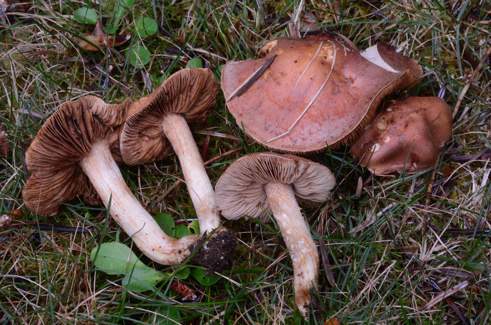 Hebeloma kelloggense (Photo: N. Siegel)
Hebeloma kelloggense (Photo: N. Siegel)Taxonomy
Full name: Hebeloma kelloggense A.H. Sm., V.S. Evenson & Mitchel, The Veiled Species of Hebeloma in the Western United States: 110 (1983)Genus: Hebeloma
Section: Theobromina
Types: UNITED STATES: Idaho: Shoshone, near Kellogg (approx. 47.5383°N, 116.1183°W, alt. approx. 700 m a.s.l.) in coniferous woodland, 21 Sep. 1966, A.H. Smith (73592) (Holotype. herbarium acc. no. MICH 5551, HJB1000412).
- arrow_drop_downarrow_drop_upEtymology
- arrow_drop_downarrow_drop_upOriginal diagnosisPileus 3-6 cm latus, convexus demum late-umbonatus, glaber, glutinosus, obscure cinnamomeus, in siccati vinaceobrunneus, odor pungens. Lamellae latae, confertae, adnatae brunneolae demum subfulvae. Stipes 6-9 cm longus, 5-10 mm crassus, albus, non brunnescens; velum sparsum, fibrillosum. Sporae 9-12 x 5-6.5 µm, dextrinoideae, subleves, inequilaterales. Basidia tetraspora. Cheilocystidia 27-57 x 8-9 x 7-11 µm, cylindric-subcapitata, capitellum 8-9 μm diam; vel subclavatta vel contorta, et 27-36 x 6-7 x 7-11 µm, non elongata.
- arrow_drop_downarrow_drop_upEnglish translationPileus 3-6 cm broad, convex then broadly umbonate, glabrous, slimy, dull cinnamon, vinaceous-brown when dried, smell pungent. Lamellae broad, crowded, adnate, brownish then pale fulvous. Stipe 6-9 cm long, 5-10 mm thick, white, not discolouring brown; veil sparse, fibrillose. Spores 9-12 x 5-6.5 µm, dextrinoid, almost smooth, inequilateral. Basidia four-spored. Cheilocystidia 27-57 x 8-9 x 7-11 µm, cylindrical-capitate, apex 8-9 μm in diameter; or subclavate or twisted, and 27-36 x 6-7 x 7-11 μm, not elongate.
References
Description
- arrow_drop_downarrow_drop_upThresholds
Description of Hebeloma kelloggense based on 10 collections
- arrow_drop_downarrow_drop_upMacroscopic descriptionPileus: 30–48 (64) mm diameter; shape often convex or umbonate, occasionally broadly umbonate; characters Not recorded; margin characters often smooth, occasionally involute or scalloped; viscosity tacky when moist; colour variation unicolour; colour at centre often cinnamon, occasionally orange-brown or yellowish brown.
Lamellae: attachment often emarginate, occasionally adnate or adnexed; maximum depth up to 8 mm; number of complete lamellae 72–88; presence of tears absent; white fimbriate edge present.
Cortina presence: no.
Stipe: (35) 36–73 (90) x (5) 6–9 (12) {median} x (5) 6–9 (10) {basal} mm; stipe Q 5.1–12.0; base shape cylindrical, occasionally clavate; floccosity usually pruinose at apex, occasionally fibrillose, floccose or pruinose; rooting no; thick rhizoids at base absent;
Context: Texture firm; stipe interior stuffed; stipe flesh discolouring usually no, occasionally yes; slenderness measure 6.8–18.8; smell often raphanoid, occasionally cocoa or earthy; taste mild where recorded.
Spore deposit colour: Not recorded.
Exsiccata characters: Not recorded.
- arrow_drop_downarrow_drop_upMicroscopic descriptionSpores: shape amygdaloid, rarely navicular; colour in microscope often yellow brown, occasionally yellow; guttules often yes, occasionally no. papilla usually no, occasionally yes; Spore Code: O2; P0 P1; D3 D4.
Basidia: 23–34 (36) x 5–8 μm; ave. Q 3.6–4.6; spore arrangement 4 spored;
Cheilocystidia: main shape usually clavate-lageniform or clavate-ventricose, rarely capitate-stipitate, gently clavate or ventricose; special features observed often median thickening or septa, occasionally apical thickening or geniculate, rarely irregular; cheilocystidia ratios: A/M = 1.36–2.06; A/B = 0.92–1.50; B/M = 1.37–1.59.
Pleurocystidia: none seen.
Ixocutis: epicutis thickness (measured from exsiccata) up to 170 μm; ixocutis hyphae width up to 7 μm; ixocutis hyphae encrustation often yes, occasionally no; shape of trama elements beneath subcutis often ellipsoid, occasionally cylindrical, thickly sausage-shaped or thinly sausage-shaped up to 16 μm wide.
Caulocystidia: Similar to cheilocystidia but larger, up to 95 μm.
- arrow_drop_downarrow_drop_upSpore measurements
- arrow_drop_downarrow_drop_upCheilocystidia measurements
- arrow_drop_downarrow_drop_upHabitat and distributionHebeloma kelloggense's preferred habitat appears to be urban parkland with grassy soil. Where only one possible associate was recorded, the most commonly recorded associate was Pinus (50.0%) but Pseudotsuga (50.0%) were also recorded. In these cases the most commonly recorded family was Pinaceae (100.0%). We have additional records where Quercus (30.0%), Notholithocarpus (20.0%), Arbutus (20.0%), Tsuga (10.0%), Abies (10.0%) and Picea (10.0%) were recorded as possible associates, but in these cases a number of possible associates were mentioned. Overall the most commonly recorded families are Pinaceae (90.0%), Fagaceae (50.0%) and Ericaceae (20.0%) The growth habit of our collections was often scattered and occasionally gregarious.
According to our current collections, the species is found only in Northern America. On the continent, collections have been found only in the temperate conifer forests WWF biome The World Wildlife Fund (WWF) have divided the world into 867 terrestrial ecoregions. The ecoregion here is estimated by mapping from the GPS coordinates of the collection using data made available by Dinerstein et al (2017). Use this webtool to explore the ecoregions visually or see a full list of current ecoregions on Wikipedia. (Northern California coastal forests (50.0%) and Puget lowland forests (40.0%) ecoregions). From collector information, it appears collections have been found in the 1.4 Forest – Temperate (57.1%) and 14.5 Urban Areas (42.9%) IUCN habitats We map from the collector's description of the habitat to the International Union for Conservation of Nature (IUCN)'s definition using a standardised set of rules. Please see this page for a full list of IUCN habitats.. Within Northern America we have records from Southwestern U.S.A. (California), Western Canada (British Columbia) and Northwestern U.S.A. (Idaho).
Geographic distribution
Phenology
- arrow_drop_downarrow_drop_upAdditional cited collections